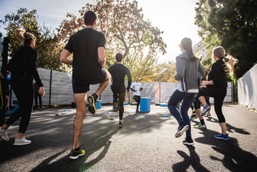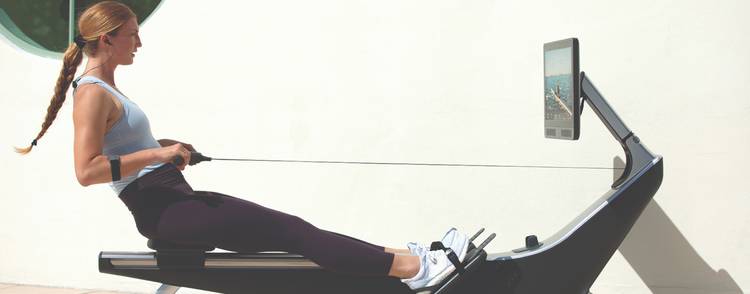
11 Tips for Safe Exercise in the Summer Heat
Exercising in the scorching summer heat can be tricky. Sun tans can easily turn into sunburns, and overexertion can quickly turn into heat exhaustion if you’re not careful. But there are also tons of benefits to exercising outdoors, like vitamin D exposure, fresh air, and a change of scenery.
So before you let the rising temps stop you from taking your workout outside, take a look at our top 11 tips to safely and effectively exercise in the summer heat.
Related: Can gym equipment be left outside?
Know Before You Go: What are the Signs of Heat Exhaustion?
Heat-related illnesses can be very serious. And if the proper actions aren’t taken, they can often be life-threatening. That’s why it’s essential to understand the signs of heat exhaustion (which can lead to heat stroke) before taking your exercise outside this summer.
According to the CDC, heat exhaustion is the body’s response to an excessive loss of water and salt, usually caused by abundant sweating. While heat exhaustion can impact anyone, children, the elderly, and those suffering from high blood pressure are at higher risk.
Symptoms of Heat Exhaustion:
- Nausea or vomiting
- Headache
- Dizziness
- Weakness
- High body temperature (103 degrees F or higher)
- Hot, red, dry, or damp skin
- Fast, strong pulse
- Passing out
Symptoms of Heat Stroke:
- Loss of consciousness
- Seizures
- Hot, dry skin
- Confusion, slurred speech
Tips for Safe and Effective Summer Exercise
1. Acclimate to the Heat Gradually
During the first few weeks of summer, take some time to acclimate to the hot temps. Think progressive overload but with the sun. Start with shorter workouts (20 min jogs vs longer runs) and slowly increase the duration or intensity over 1-2 weeks. During this time, pick a day when you intentionally work out during the hottest part of the day. This will help prevent you from shocking your nervous system, and ensure your summer is full of successful outdoor workouts.
2. Avoid Mid-Day Workouts
The middle of the day (between 10 a.m. and 3 p.m.) is when the sun is at its highest, and temperatures are at their hottest. Unless it’s an acclimation day, try to plan your training in the morning or the evening when the heat index is lower. Otherwise, look for shady trails, parks, or pavilions that can help protect you from the UV rays.
3. Hydrate, Hydrate, Hydrate!
One of the biggest concerns with exercising in the summer heat is the risk of dehydration. That’s why it’s crucial to hydrate before, during, and after exercising this season. Aim to consume somewhere between 15-20 ounces of water a few hours before exercising, and then every 15-30 minutes during training. But don’t overdo it – you don’t want to be sick as you start moving.
To maintain your hydration levels during your workout, look for a park or trail that has frequent water fountains. Or bring a reusable water bottle (or a hydration backpack) along for the ride.
4. Skin Protection
Exercising in the heat and humidity is hard enough without having to navigate the stinging pain of a sunburn. Since your skin is your body’s first line of defense for cooling down, a sunburn reduces this ability which causes a loss of body fluids.
Before you head outdoors this summer, throw on a hat and make sure to lather up with broad-spectrum sunscreen. This not only helps prevent painful sunburns but also helps protect your skin from premature aging and skin cancer. In a pinch, UV-protective clothing that contains UPF 50+ can also help block harmful rays.
Pro tip: soak your hat in water before you go out – it will help keep your head cool and comfortable!
5. Wear Lightweight, Breathable Fabrics
Dark colors are like a magnet for the sun’s harsh rays. Great during the winter, but avoid them at all costs during the summer. When dressing for your outdoor summer exercise, choose light-colored clothing that will help reflect the sun and excess heat. Look for pieces made from fabrics like polyester, nylon, or lycra – they allow for airflow and easily wick away sweat to keep you cool and dry.
6. Consume Electrolytes and Energy Chews
While water is crucial for safely exercising in the summer heat, so are electrolyte-filled sports drinks. The sun zaps your electrolytes. And an imbalance in electrolytes (low sodium) combined with drinking too much water can lead to a condition called Hyponatremia.
Look for a sports drink chock full of electrolytes (but not tons of sugar) or concentrated energy chews to consume during outdoor sessions. This will not only help prevent dehydration but will also help combat nasty cramps.
7. Use Cooling Accessories
Studies show that cooling your core body temperature during training can have positive effects on exercise performance. [1] Not to mention, a cooling neck towel feels fantastic after a few hours under the burning sun.
Pack a few cooling accessories like cooling neck wraps, bandanas, or vests when doing outdoor workouts this summer. Or try soaking a towel and freezing it overnight. Pack it in a cooler before training and it will be nice and refreshing for you as it thaws.
8. Embrace Water-Based Workouts
There’s nothing more refreshing on a hot summer day than a quick dip in the pool or a lap in the lake. On days when it’s too warm for a workout on land, opt for a low-impact water-based workout to get your heart pumping. Swimming, water aerobics, and paddle boarding are all great for building cardiovascular endurance and burning calories.
9. Choose the Right Workout
Even if you’re an avid marathon runner, your go-to workout style might be too intense on hot, humid summer days. When you exercise, your body produces sweat to cool you down and regulate body temperature. When there’s excess heat and moisture in the air, your sweat doesn’t evaporate from your skin as quickly, which traps body heat and can make exercise feel more exhausting. [2]
Instead, try HIIT, cycling, or yoga training on scorching-hot days. These workouts offer ample opportunities for breaks so you can avoid overexertion.
10. Listen to Your Body and Take Breaks as Needed
You know your body’s limits better than anyone. And if you begin to feel faint, dizzy, or nauseous while exercising outdoors this summer, that’s your body telling you to stop. It’s important to keep the signs of heat exhaustion top of mind during outdoor activities and avoid pushing beyond your limits. To avoid overheating, take frequent breaks and seek out shady areas, like pavilions or trees, to lower your body temperature between sets. And don’t forget your water!
11. Stay Indoors When Necessary
There’s hot, and then there’s hot. When the risks of exercising in the summer heat outweigh the rewards, consider taking your workout indoors. On these blazing hot days, it’s helpful to have gym equipment on hand so there’s no disruption to your fitness routine. If you’re ready to build your dream home gym, check out our guide that offers tips on picking the right pieces, and 10 award-winning products you can find at Fitness Town.
[1] Bongers CC, Hopman MT, Eijsvogels TM. Cooling interventions for athletes: An overview of effectiveness, physiological mechanisms, and practical considerations. Temperature (Austin). 2017 Jan 3;4(1):60-78. doi: 10.1080/23328940.2016.1277003. PMID: 28349095; PMCID: PMC5356217.
[2] Che Muhamed AM, Atkins K, Stannard SR, Mündel T, Thompson MW. The effects of a systematic increase in relative humidity on thermoregulatory and circulatory responses during prolonged running exercise in the heat. Temperature (Austin). 2016 May 18;3(3):455-464. doi: 10.1080/23328940.2016.1182669. PMID: 28349085; PMCID: PMC5079215.

